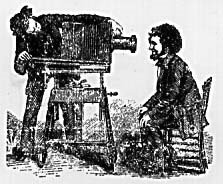“Time,” my short story from Postcards, tells the story of an old man and his true love. The postcard that this story is written about reads “Dear Myrtle, now don’t get brain fever trying to figure out who this is from. Just think apple cake + lemon slice & you got it.” This postcard represents an important turning point in the old man’s life. He had fallen in love with one of the waitresses, Myrtle, and he used the postcard as a valentine to tell her how he felt. While their love story had a happy ending, the old man’s story is not as uplifting. He claims that he no longer has anything to live for, and has a feeling that he is about to die. Instead of being upset about the situation, the old man passively accepts his situation and welcomes the idea of being with Myrtle again.
This short story addresses themes of love, age & youth, satisfaction, and change. Visually, it is generally solemn in mood, with the old man’s character rarely smiling. The author is constantly changing the scope of the panel, zooming in on certain aspects and panning out on others to emphasize times that the old man is the center of the idea and other times when he is observing the situation. The number of panels used varies throughout the story, but there are typically three rows of panels on each page. The fragmentation of Dialogue and thoughts are represented in a few ways, with dialogue in bubbles and thoughts generally in rectangular boxes. Thoughts are also frequently fragmented by the panels and boxes, which helps to isolate certain ideas and organize the general flow of the story.
announcements
This blog was created by and for students in an Introduction to Cultural Studies class at the University of Washington. Through an investigation of urban experience and representation--in theory, in graphic novels and in our own "readings" of Seattle's University District--we considered the formation and history of cultural studies as an (anti)discipline, with a special emphasis on the questions, "What does cultural studies do, and how do you do cultural studies?"
If you'd like to know more about the class, the blog or our U-District artifact project, please contact Gabrielle Dean: gnodean@u.washington.edu.
If you'd like to know more about the class, the blog or our U-District artifact project, please contact Gabrielle Dean: gnodean@u.washington.edu.
Subscribe to:
Post Comments (Atom)
blog archive
-
▼
2008
(92)
-
▼
May
(26)
- Seattle U District: City Artifacts Map
- City Artifacts: What and Where?
- Researching History and its Representations...
- Palestine
- Persepolis 1 & 2
- Shutterbug Follies
- A Scanner Darkly
- Maus I & II
- A Scanner Darkly
- Maus I & II
- Shutterbug Follies
- Persepolis 1 and 2
- Postcards: True Stories that Never Happened
- Maus I & II
- Postcards: True Stories that Never Happened
- Persepolis 1 & 2
- Mail Order Bride
- Mail Order Bride: Mark Kalesniko
- Persepolis 1 & 2
- Shutterbug Follies
- Maus I and II
- Palestine
- Postcards: True Stories That Never Happened
- PALESTINE
- Postcards: True Stores That Never Happened
- Shutterbug Follies
-
▼
May
(26)

2 comments:
Going back to what we had discussed in class today, many of the stories in Postcards deal with the theme of death. “Time” is unique because the old man awaits his death, but he isn’t afraid of dying. His death is what will reunite him with Myrtle. I think this difference in the tone is shown through the images. In other stories that involve death, the images are extremely dark and upsetting. There are disturbing drawings in some of them, like the Underwear story where we see a body in a bag. I really enjoyed reading “Time” because its appearance was so different from all of the other stories. It was simple and easy to follow. The simplicity of the images matched well with the somber tone of the story. I’m glad you chose to analyze “Time” because it was the one of stories that stood out from the others.
I agree with Aileen; Time was one of the few happier stories in the collection, both textually and visually. While death is definitely one of the common themes in Postcards, here it's not a horrific disease or shocking horror. The old man in this story was peacefully looking forward to death and had a positive attitude about what would happen. The style was very simple, much like the man himself - he obviously always ordered the same thing at the coffee shop, and he talked about his impressions of the young people he sees. There were just a few images, like the old man's face and the postcard, which repeated often in various "zoomed" in or out versions, which made it even more simple but still interesting. Plus the style and font were cute. Good choice!
Post a Comment